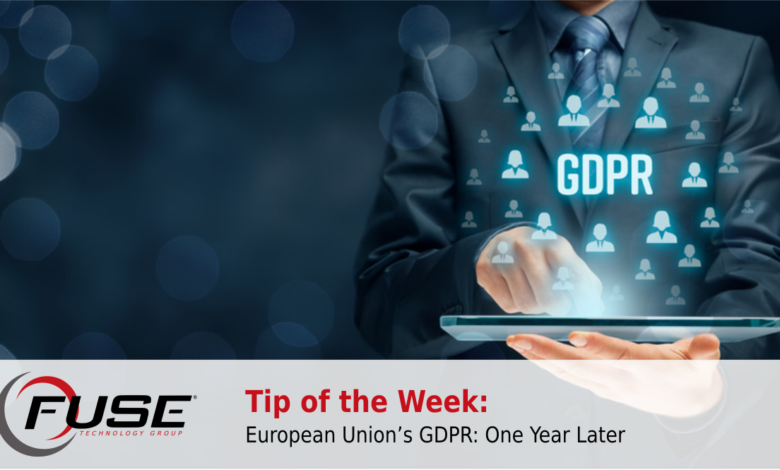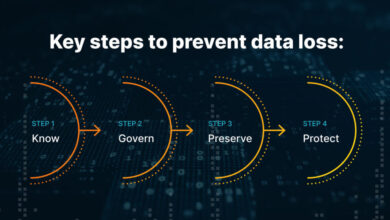
GDPR One Year On A Retrospective
GDPR One Year On: It feels like just yesterday the General Data Protection Regulation swept across Europe, causing a whirlwind of compliance efforts and anxieties. Now, a year later, we can finally step back and assess the impact. Did businesses truly adapt? Did consumer trust actually improve? This post dives into the successes, failures, and lingering questions surrounding GDPR’s first year.
From initial struggles with understanding the complexities of the regulation to the evolving strategies employed by businesses of all sizes, we’ll explore the key lessons learned. We’ll examine the landscape of fines, the successes and failures of data subject access requests (DSARs), and the broader impact on data security practices. We’ll even peek into the international cooperation (or lack thereof) that defined this crucial first year.
GDPR Compliance One Year After Implementation
The first year after the General Data Protection Regulation (GDPR) came into effect was a whirlwind of activity for businesses across Europe and beyond. The sweeping changes to data privacy laws presented significant challenges, forcing organizations to re-evaluate their data handling practices and invest heavily in compliance efforts. While the initial panic subsided, the long-term implications of GDPR are still being felt, and the learning curve continues.
Reflecting on GDPR one year on, it’s clear data security is paramount. The shift to cloud-based systems necessitates robust security measures, which is why understanding solutions like those offered by Bitglass is crucial. Check out this insightful article on bitglass and the rise of cloud security posture management to see how they help organizations meet compliance requirements, especially in light of GDPR’s ongoing impact.
Initial Challenges Faced by Businesses
Achieving GDPR compliance within the initial timeframe proved exceptionally difficult for many organizations. The sheer volume of data needing assessment, the complexities of consent management, and the lack of clear guidance in certain areas created significant hurdles. Many companies struggled with outdated data management systems, lacking the technological infrastructure to effectively track and manage personal data. Furthermore, a significant challenge involved educating employees on the new regulations and implementing appropriate training programs.
The cost of compliance, including legal fees, technological upgrades, and staff training, was also a major concern for businesses of all sizes.
Common Mistakes Made During the First Year of GDPR Enforcement, Gdpr one year on
Several recurring mistakes emerged during the first year of GDPR enforcement. Many organizations failed to conduct thorough data mapping exercises, leading to an incomplete understanding of the personal data they held. Inadequate consent mechanisms were widespread, with many organizations relying on pre-checked boxes or unclear consent forms. Data breaches, unfortunately, also remained a common occurrence, often stemming from insufficient security measures or inadequate incident response plans.
A significant number of companies also failed to adequately address data subject access requests (DSARs) in a timely and efficient manner. Finally, many overlooked the importance of appointing a Data Protection Officer (DPO), especially those who did not fall under the mandatory requirements.
Evolution of GDPR Understanding and Application
The first year saw a significant evolution in the understanding and application of GDPR. Initially, there was considerable uncertainty surrounding many aspects of the regulation, leading to a cautious and sometimes overly restrictive approach by some businesses. As time went on, however, a clearer understanding of the requirements emerged, driven by enforcement actions, guidance from supervisory authorities, and the sharing of best practices among organizations.
This led to a more nuanced and proportionate approach to compliance, focusing on risk-based assessments and tailored solutions. The initial focus on strict adherence to the letter of the law gradually shifted towards a more contextual interpretation, prioritizing the protection of individual rights while acknowledging the practical challenges faced by businesses.
Examples of Successful GDPR Compliance Strategies
Several organizations demonstrated successful GDPR compliance strategies. Companies with robust data governance frameworks in place, including comprehensive data mapping and regular data audits, were better positioned to comply. Organizations that invested in advanced data security technologies, such as encryption and access control systems, were better able to protect personal data from breaches. Those who proactively engaged with their data subjects, providing clear and accessible information about their data processing activities, also demonstrated strong compliance.
Furthermore, companies that implemented comprehensive employee training programs and integrated GDPR compliance into their overall business strategy experienced a smoother transition. For example, a major telecommunications company invested heavily in automating data subject access requests, reducing processing time significantly and improving customer satisfaction.
Types of GDPR Fines Levied in the First Year
The fines levied during the first year of GDPR enforcement varied significantly in severity, depending on the nature and severity of the violation. Smaller fines were often issued for less serious infringements, such as inadequate documentation or minor data breaches with limited impact. However, several organizations faced substantial fines for more serious violations, including large-scale data breaches, unlawful data processing, and failure to comply with data subject access requests.
For instance, a significant fine was levied against a hotel chain for failing to adequately protect customer data resulting in a major data breach. Another company faced a substantial penalty for processing sensitive personal data without proper consent. The fines served as a strong deterrent, emphasizing the importance of robust compliance measures. The range of fines reflected the varied levels of non-compliance, acting as a clear indication of the seriousness with which data protection authorities view breaches of the GDPR.
Data Subject Rights
A year after the GDPR’s implementation, it’s crucial to assess its impact on data subject rights. The regulation empowered individuals with significant control over their personal data, leading to a surge in data subject requests and forcing organizations to adapt their data management practices. This review examines the real-world experiences of businesses in handling these requests, highlighting the challenges and successes encountered.
Real-World Examples of Data Subject Requests and Organizational Responses
Organizations have faced a wide range of data subject requests. One example involves a customer requesting access to all their personal data held by an online retailer. The retailer, having implemented a robust DSAR process, provided a comprehensive report including order history, contact information, and browsing data within the legally mandated timeframe. Conversely, a smaller business struggled to fulfill a similar request due to inadequate data organization and a lack of dedicated personnel.
This resulted in delays and frustration for the data subject. Another common request is the right to rectification, where individuals ask to correct inaccurate information. A bank, for example, successfully rectified a customer’s incorrect address after receiving a formal request, demonstrating efficient internal processes.
Reflecting on GDPR a year on, it’s clear data privacy is paramount. Building compliant applications requires careful consideration, and that’s where the speed and efficiency of low-code/no-code platforms become crucial. For example, check out this insightful article on domino app dev the low code and pro code future to see how they’re addressing this. Ultimately, streamlined development helps ensure GDPR compliance while boosting productivity; a win-win for developers and users alike.
Processes for Handling Data Subject Access Requests (DSARs) Efficiently
Efficient DSAR handling requires a multi-faceted approach. Many organizations established dedicated DSAR teams responsible for receiving, processing, and responding to requests. These teams often use specialized software to track requests, manage deadlines, and ensure compliance. Clear internal protocols, including data mapping exercises to locate relevant data, are also essential. The use of automated systems can streamline parts of the process, such as initial request acknowledgment and data extraction, but human oversight remains crucial for complex or sensitive requests.
Well-defined escalation paths for challenging requests further ensure timely and accurate responses.
Impact of DSARs on Organizational Workflows and Data Management Practices
The influx of DSARs has significantly impacted organizational workflows and data management. Many businesses have invested in improved data governance and security measures to ensure they can readily locate and manage personal data. This includes implementing data minimization practices, enhancing data security protocols, and regularly auditing data holdings. The process of handling DSARs has also highlighted the importance of accurate and up-to-date data records.
The increased scrutiny has encouraged a shift towards more transparent and accountable data handling practices.
Comparison of DSAR Management Between Small Businesses and Large Corporations
Large corporations generally have more resources to dedicate to DSAR management, often employing dedicated teams and sophisticated technologies. They are better positioned to handle the volume of requests and ensure compliance. Small businesses, on the other hand, often face greater challenges due to limited resources and staff. They may struggle to dedicate sufficient time and expertise to DSAR processing, potentially leading to delays or non-compliance.
However, many small businesses have successfully adapted by leveraging external expertise or adopting simpler, yet effective, data management solutions. The financial burden of compliance can be significantly higher for smaller entities.
Data Subject Rights and Their Practical Implications
| Right | Description | Practical Implications | Example |
|---|---|---|---|
| Right of Access | The right to obtain confirmation of whether or not personal data concerning you is being processed, and, where that is the case, access to the personal data and certain supplementary information. | Organizations must provide individuals with a copy of their data within one month. | A customer requests a copy of their order history from an online retailer. |
| Right to Rectification | The right to have inaccurate personal data concerning you rectified without undue delay. | Organizations must correct inaccurate data promptly. | A customer requests correction of their misspelled name in a company database. |
| Right to Erasure (“Right to be Forgotten”) | The right to have personal data concerning you erased without undue delay under certain circumstances. | Organizations must delete data if it is no longer necessary, the processing is unlawful, or the individual withdraws consent. | A user requests deletion of their account and associated data from a social media platform. |
| Right to Restriction of Processing | The right to restrict processing of your personal data under certain circumstances. | Organizations may only store the data, not further process it. | A customer disputes the accuracy of their data and requests processing be restricted until the issue is resolved. |
Impact on Data Security and Privacy Practices: Gdpr One Year On
One year after the GDPR’s implementation, its impact on data security and privacy practices is undeniable. The regulation has acted as a powerful catalyst, forcing organizations to re-evaluate their data handling procedures and invest heavily in bolstering their security infrastructure. This shift hasn’t been without its challenges, but the overall effect has been a significant improvement in the protection of personal data across Europe and beyond.Key changes in data security and privacy practices are evident across various sectors.
We’ve seen a noticeable increase in proactive risk assessments, more robust data encryption methods, and a greater emphasis on data minimization and purpose limitation. Companies are also showing a stronger commitment to transparency, providing individuals with clearer and more accessible information about how their data is being used.
Changes in Data Security and Privacy Practices
The GDPR’s influence has led to a significant shift in organizational approaches to data protection. Prior to GDPR, many organizations adopted a reactive, compliance-driven approach to data security. Post-GDPR, a proactive and preventative approach is becoming the norm. This includes implementing robust data loss prevention (DLP) measures, regularly auditing data security practices, and investing in employee training programs focused on data protection.
This shift towards proactive security reflects a change in mindset – data protection is no longer viewed as a mere compliance exercise, but as a crucial element of business strategy.
Influence of GDPR on Data Protection Technologies
The GDPR has significantly accelerated the development and adoption of new data protection technologies. For example, there’s been a surge in demand for solutions that facilitate data subject access requests (DSARs), allowing organizations to quickly and efficiently respond to individual requests for their data. Privacy-enhancing technologies (PETs), such as differential privacy and federated learning, are also gaining traction, enabling organizations to analyze data while minimizing the risk of identifying individuals.
Furthermore, the increasing importance of data anonymization and pseudonymization has driven the development of more sophisticated tools and techniques to achieve these goals. The market for data security and privacy tools has exploded, reflecting the growing need for solutions that meet the GDPR’s stringent requirements.
Impact of GDPR on Data Breach Notification Procedures and Response Times
GDPR’s stringent data breach notification requirements have had a profound effect on how organizations handle security incidents. The 72-hour notification deadline has forced companies to develop faster and more efficient breach response plans. This has led to improvements in incident detection capabilities, improved communication protocols, and a greater focus on minimizing the impact of breaches on affected individuals.
While there have been challenges in meeting the tight deadlines, the overall result has been a quicker and more coordinated response to data breaches, leading to potentially reduced harm to individuals. A notable example is the increased use of automated systems for breach detection and notification, streamlining the process and improving response times.
Evolution of Data Protection Officer (DPO) Roles and Responsibilities
The DPO role has evolved significantly since the GDPR’s implementation. Initially, many organizations viewed the DPO as a purely compliance-focused role. However, the reality is that DPOs are now increasingly involved in strategic decision-making regarding data protection. Their responsibilities extend beyond mere compliance to encompass data protection strategy development, risk management, and the implementation of data protection technologies.
It’s been a year since GDPR came into effect, and while some progress has been made, data privacy breaches still happen. For example, I was shocked to read about Facebook’s recent request for users’ bank account and card transaction details, as reported in this article: facebook asking bank account info and card transactions of users.
This highlights how much work is still needed to truly protect user data, even a year after GDPR’s implementation. It makes you wonder what else is going on behind the scenes.
DPOs are becoming key players in shaping an organization’s approach to data privacy, ensuring that data protection is integrated into all aspects of the business. This reflects a growing understanding that data protection is not just a legal requirement, but a vital component of business operations.
Hypothetical Data Breach Scenario and Compliant Response
Imagine a fictional online retailer, “ShopSmart,” experiences a data breach. A malicious actor gains unauthorized access to its customer database, compromising names, addresses, email addresses, and payment card details of 10,000 customers. ShopSmart, a GDPR-compliant organization, immediately initiates its incident response plan. Within hours, they identify the breach’s scope and contain the intrusion. The IT team works to secure the system and prevent further data leakage.
Within 72 hours, ShopSmart notifies the relevant supervisory authority and all affected individuals about the breach, explaining what happened, the types of data compromised, and the steps being taken to mitigate the damage. They offer credit monitoring services to affected customers and provide them with support and resources. ShopSmart also conducts a thorough post-incident review to identify vulnerabilities and improve its security practices, preventing similar incidents in the future.
This proactive and transparent response demonstrates the organization’s commitment to GDPR compliance and its dedication to protecting its customers’ data.
Cross-Border Data Transfers and International Cooperation
One year after GDPR’s implementation, the complexities of cross-border data transfers remain a significant challenge for businesses operating internationally. The regulation’s impact extends beyond national borders, necessitating international cooperation and a nuanced understanding of varying enforcement approaches. This discussion will explore the diverse implementations of GDPR across different nations, the successes and challenges of international data transfers, the role of Data Protection Authorities (DPAs), and practical examples of successful cross-border mechanisms.
Varied Approaches to GDPR Implementation and Enforcement
While the GDPR provides a uniform legal framework, its implementation and enforcement differ significantly across member states. Some countries have adopted a more proactive and stringent approach, with DPAs actively investigating and imposing substantial fines. Others have taken a more lenient stance, prioritizing guidance and cooperation over immediate punitive measures. This disparity stems from factors such as existing national data protection laws, resource allocation for DPAs, and differing interpretations of the GDPR’s provisions.
For instance, the UK’s Information Commissioner’s Office (ICO) has been relatively proactive in enforcement, while other DPAs have focused more on educational initiatives. This variation creates a complex landscape for multinational companies navigating compliance across multiple jurisdictions.
Challenges and Successes of International Data Transfers Under GDPR
The GDPR’s restrictions on data transfers outside the European Economic Area (EEA) present both challenges and opportunities. The reliance on adequacy decisions, standard contractual clauses, and binding corporate rules (BCRs) as transfer mechanisms has created complexities. Challenges include ensuring the adequacy of data protection in third countries, negotiating and managing complex contractual arrangements, and demonstrating compliance with the GDPR’s stringent requirements for data transfers.
Successes, however, include the increased awareness of data protection among businesses, the development of innovative transfer mechanisms, and a greater focus on data security practices. The increased scrutiny has pushed organizations to strengthen their data protection protocols.
The Role of Data Protection Authorities (DPAs) in Facilitating Cross-Border Cooperation
DPAs play a crucial role in facilitating cross-border cooperation by establishing communication channels, coordinating investigations, and promoting consistent enforcement of the GDPR. The GDPR’s “one-stop shop” mechanism allows companies to interact with a single DPA for processing activities across multiple member states, simplifying compliance. However, effective cooperation requires efficient communication and a shared understanding of the GDPR’s provisions.
Challenges remain in coordinating investigations involving multiple DPAs and ensuring consistent enforcement across different jurisdictions. Increased collaboration and the development of standardized procedures are crucial for improving the effectiveness of cross-border cooperation.
Examples of Successful Cross-Border Data Transfer Mechanisms
Several multinational corporations have successfully implemented cross-border data transfer mechanisms compliant with the GDPR. Many rely on standard contractual clauses (SCCs) approved by the European Commission, providing a framework for data transfers to third countries. Others have implemented binding corporate rules (BCRs), which are internal company policies approved by a DPA, enabling consistent data protection across the organization’s global operations.
These mechanisms, when properly implemented and monitored, offer a viable pathway for compliant international data transfers. Success hinges on thorough due diligence, robust security measures, and ongoing compliance monitoring.
Key Considerations for Businesses Transferring Data Internationally
Before embarking on international data transfers, businesses must carefully consider several crucial factors.
- Adequacy Decisions: Determine if the destination country has an adequacy decision from the European Commission.
- Standard Contractual Clauses (SCCs): Implement SCCs and ensure they are properly incorporated into contracts with data processors and recipients.
- Binding Corporate Rules (BCRs): Explore the feasibility and benefits of implementing BCRs for consistent data protection across global operations.
- Data Security Measures: Implement robust security measures to protect data throughout its lifecycle, regardless of location.
- Data Protection Impact Assessments (DPIAs): Conduct DPIAs for high-risk data processing activities involving international data transfers.
- Transparency and Accountability: Maintain transparency with data subjects about international data transfers and establish clear accountability mechanisms.
- Compliance Monitoring: Regularly monitor compliance with GDPR requirements for international data transfers.
The Evolving Landscape of GDPR Enforcement

The first year of GDPR enforcement painted a dynamic picture, revealing both the challenges and successes of implementing such a sweeping data protection regulation. While initially marked by a period of relative leniency as organizations scrambled to achieve compliance, a clear trend towards stricter enforcement emerged as DPAs (Data Protection Authorities) gained experience and confidence. This shift has significantly impacted business practices and consumer trust, leading to a new era of data responsibility.
The initial months following the May 2018 deadline saw a focus on guidance and warnings, prioritizing education and remediation over immediate penalties. However, this approach gradually transitioned to a more assertive stance, with DPAs across Europe increasingly issuing substantial fines and enforcement actions against non-compliant organizations. This evolution reflects a growing understanding of the GDPR’s provisions and a determination to ensure its effective implementation.
Types of Sanctions and Penalties Imposed by DPAs
The range of sanctions imposed by DPAs across Europe has been significant, reflecting the varying interpretations and enforcement priorities of different national authorities. Fines have constituted a major component, with amounts varying considerably based on factors such as the severity of the violation, the size of the organization, and the number of individuals affected. Beyond monetary penalties, DPAs have also issued warnings, reprimands, cease-and-desist orders, and even temporary or permanent suspension of data processing activities.
For instance, the CNIL (French DPA) has consistently been among the most active in issuing substantial fines, while other DPAs have prioritized collaborative approaches focusing on guidance and remediation. This divergence highlights the complexities inherent in achieving consistent enforcement across the EU.
Impact of GDPR Enforcement on Business Practices and Consumer Trust
GDPR enforcement has undeniably reshaped business practices. Companies have invested heavily in data protection infrastructure, implementing robust data governance frameworks, enhancing data security measures, and refining consent mechanisms. This has led to a greater focus on data minimization, purpose limitation, and accountability. The increased transparency and control afforded to data subjects have, in turn, fostered a degree of consumer trust, though the full impact on consumer confidence remains an ongoing area of study.
Many organizations now proactively engage with DPAs and actively seek compliance advice, demonstrating a shift from reactive to proactive compliance strategies.
Examples of Organizational Adaptations to Enforcement Actions
Several high-profile cases illustrate how organizations have adapted to GDPR enforcement actions. For example, some companies facing fines for data breaches have implemented more rigorous security protocols, including enhanced employee training and improved incident response plans. Others, facing criticism for opaque consent practices, have redesigned their consent mechanisms to be more transparent and user-friendly. These adaptations demonstrate a move towards a more responsible and proactive approach to data protection, prioritizing compliance not just as a legal obligation but as a strategic imperative.
Potential Impact of Future GDPR Enforcement on Business Strategies
Looking ahead, the trend towards stricter enforcement is likely to continue. DPAs will likely focus on complex areas such as automated decision-making, AI, and cross-border data transfers. Businesses should anticipate increased scrutiny and potentially higher fines for non-compliance. This necessitates a proactive approach to compliance, integrating data protection into core business strategies and fostering a culture of data responsibility throughout the organization.
Failure to adapt to this evolving landscape could lead to significant financial and reputational damage, making robust GDPR compliance a crucial factor in long-term business sustainability.
Summary

Looking back at GDPR’s first year reveals a mixed bag. While the initial panic subsided, the journey to true compliance continues. The regulation has undoubtedly spurred significant improvements in data protection practices and has heightened awareness of data privacy rights. However, challenges remain, especially concerning cross-border data transfers and the consistent enforcement of the regulation across different member states.
The evolving landscape of GDPR enforcement suggests a long road ahead, but one that’s ultimately shaping a more responsible and accountable digital world.
Top FAQs
What are the most common misconceptions about GDPR?
Many believe GDPR only applies to large corporations. It applies to any organization processing the personal data of EU residents, regardless of size or location. Another misconception is that simply having a privacy policy is enough. True compliance requires a comprehensive approach to data handling, storage, and security.
How much does GDPR compliance actually cost?
The cost varies significantly depending on the organization’s size, industry, and existing data management practices. Smaller businesses may find it relatively affordable to implement basic measures, while larger organizations may face substantial investments in technology and personnel.
What happens if my company doesn’t comply with GDPR?
Non-compliance can lead to significant fines, ranging from millions of euros to a percentage of annual global turnover. Beyond financial penalties, reputational damage and loss of customer trust are also major risks.





